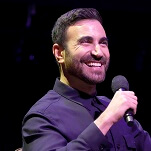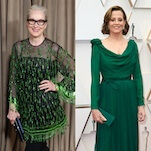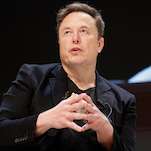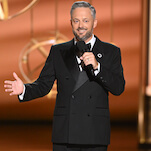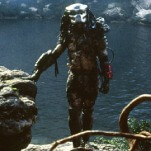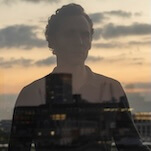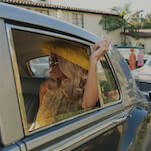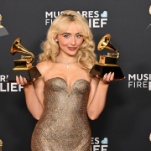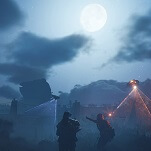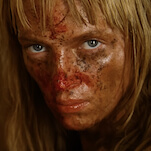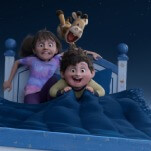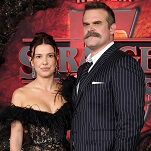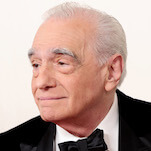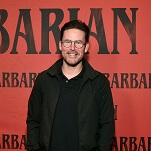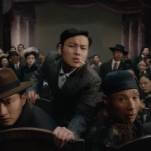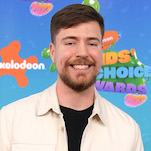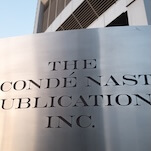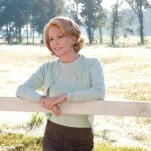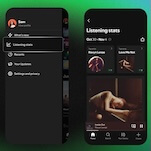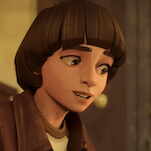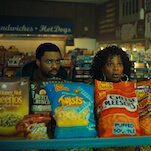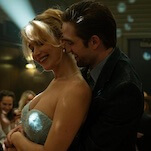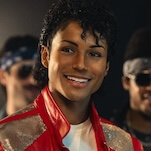With Women Of Action, Caroline Siede digs into the history of women-driven action movies to explore what these stories say about gender and how depictions of female action heroes have evolved over time.
For a long time, girls weren’t allowed to have much fun when it came to American action movies. In male-driven stories, women were either the sexy love interest or the damsel in distress. In team-up ensembles they played the bossy, mature one. And in solo films, they were breaking out of prison or getting revenge on their abusers or reeling from hidden traumas. The 1970s and ’80s saw a burst of female-led action stories that were a blast for audiences to watch, but not much fun for the characters to live through—whether that was Pam Grier avenging her dead boyfriend in Foxy Brown or Linda Hamilton and Sigourney Weaver barely surviving inhuman enemies in their respective Alien and Terminator franchises.
Even as ’90s blockbusters let male heroes have campy fun in the likes of True Lies, Bad Boys, Rush Hour, the Pierce Brosnan Bond outings, and the increasingly silly Mission: Impossible films, female action leads tended to exist in more serious dramatic fare like G.I. Jane—when they existed at all. Sarah Connor and Ellen Ripley may have shattered blockbuster glass ceilings, but Hollywood wasn’t exactly interested in continuing to raise the roof.
It was Drew Barrymore who decided to change all that. Fresh off an empowering reclamation of her child-star past in rom-coms like The Wedding Singer and Ever After, Barrymore was looking for a different kind of project for her newly formed production company Flower Films to champion. Her producing partner Nancy Juvonen heard that Sony was interested in doing a big-screen remake of Charlie’s Angels, the 1970s show that had been a favorite of theirs growing up. “Dude,” Juvonen exclaimed, “We’ve gotta get in there.”
So a 24-year-old Barrymore pulled out two VCRs and her massive collection of films in order to splice together a reel showing exactly what tone she thought the movie should aim for—Bruce Lee’s Enter The Dragon meets Goldie Hawn’s Foul Play with a dash of the musical flair from Robert Zemeckis’ Used Cars. Something girly and fun where the Angels would each have a love interest to giggle about in between kicking ass and taking names.
“[Women] want sisterhood,” Barrymore explained in 2016. “We want to have each other’s backs and then we want to meet back up in the morning and talk all about what happened at night with the boy. It’s what girls do! I was like there has to be an element of relationship so that’s why I taped this scene from Foul Play and it was just, very true to what a girl likes and feels. What if that girl also loved her girlfriends and was a real sister and they had each other’s backs and they were kickass and they loved to laugh? Because a girl without a sense of humor, oof!”
The result is 2000’s Charlie’s Angels, one of the most delightfully deranged, thrillingly high-octane, deeply divisive female-led action-comedies ever made. It’s a movie that starts with LL Cool J skydiving out of a plane only to rip off a face mask to reveal he’s actually a 5’4″ white woman. And things just get more bonkers from there. Despite mixed reviews, Charlie’s Angels was a box office success and an immediate cultural sensation—one that not only launched a killer Destiny’s Child song and kicked off a wave of other 1970s TV show adaptations, but also paved the way for a burst of female-led action blockbusters in the 2000s. For better or for worse, Charlie’s Angels primed the pump for the likes of Lara Croft: Tomb Raider, Resident Evil, Catwoman, Æon Flux, and even Quentin Tarantino’s Kill Bill series.
As with the original TV show—which ran for five seasons from 1976 to 1981—debate immediately raged upon the film’s release: Was Charlie’s Angels mere cinematic “jiggle TV” designed to soften the women’s lib movement into a glossily toothless male fantasy? Or can you find real empowerment in a movie where Barrymore distracts a mark by licking a steering wheel, Cameron Diaz is introduced dancing in Spider-Man underwear, and Lucy Liu just happens to need to dress up as a dominatrix for one of their missions?
Maybe it’s because I was the right tween age when the movie came out, but I actually lean towards the latter interpretation. Yes, Charlie’s Angels is a ridiculously oversexualized film that uses winking camp comedy to push its sexuality even further than you could in a more dramatic action vehicle. But it’s also an action movie starring three female leads with distinctive personalities who are confident, funny, feminine, good at their jobs, and devoted to one another, even as they have their own relatable foibles and struggles. That’s the sort of thing that just hadn’t really existed in American blockbuster action cinema beforehand—and still feels rare today.
In fact, just as the original 1970s TV show was part of a wave of female-led action series like Police Woman, Wonder Woman, and those aforementioned Grier films, the 2000 film was part of a burst of turn-of-the-21st-century girl power projects that hit a real sweet of empowered femininity before early aughts culture curdled into something far cruder and more vapid. Along with the likes of Miss Congeniality, Legally Blonde, and Josie And The Pussycats, not to mention TV shows like The Powerpuff Girls, Buffy The Vampire Slayer, and Xena: Warrior Princess, Charlie’s Angels joined a wave of subversive stories that said woman could be girly and silly and fashionable but still smart and strong and in solidarity with other women too. It’s the sort of thing the Barbie movie bottled so potently in 2023.
Indeed, though I’ve sometimes heard Charlie’s Angels dismissively described as a movie about women made by men, that really denies just how much agency Barrymore had in bringing the film to life. She was the one who pitched the tone and cast and hired music video helmer McG to make his directorial debut on the project. She was also adamant that the Angels not use guns and be martial arts experts instead, which allowed the film to bring in legendary Hong Kong action choreographer Yuen Cheung-yan to stage some wildly over-the-top wirework fights that were clearly inspired by the success of The Matrix the previous year. The leads spent three months training eight hours a day, five days a week to pull off the action scenes.
Though production on the movie was reportedly a mess (not least of all because of Bill Murray’s temper), there’s a palpable sense that Barrymore, Liu, and Diaz all really want to be there, which is key to making the film’s tone work. Despite a writing process that included 17 screenwriters and a plot that features an unfortunate streak of early aughts orientalism, the final film is surprisingly sleek and well-paced, with just the right stakes for this sort of story. Instead of saving the world, the Angels ultimately have to save their boss/mentor Charlie (John Forsythe, reprising his voice role from the original series). And the central trio get to bounce off some great male character actors, including Crispin Glover as the “Creepy Thin Man,” Tim Curry as a sleazy millionaire, and Sam Rockwell in what I’m pretty sure is his first-ever onscreen dancing moment. (Talk about film history!)
Among those many screenwriters, future Erin Brockovich scribe Susannah Grant was brought in specifically to work with the actresses on “giving their characters some character,” which is another key to the film’s comedic success. Part of the reason the oversexualization in Charlie’s Angels doesn’t bother me as much as it does in other action films is because the three leads are actively in on the joke—which lends the film a different tone than other skeevier action flicks. It’s less Michael Bay leering, more Austin Powers winking. The Angels are definitely sexualized, but they’re not exactly objectified because, well, they always feel like people rather than objects.
In fact, I don’t know if anyone has ever looked like they’re having more fun making a movie than Diaz does here. In her hands, Natalie is this enchanting mix of hyper-confidence and total guilelessness. Watching her roundhouse kick a bad guy only to melt into a giggly bundle of nerves around her bartender crush (Luke Wilson) is like watching Christopher Reeve switch from Superman to Clark Kent. As she did in her best ’90s work, Diaz makes Natalie so radiantly likable that you totally buy that she could get a room full of Soul Train skeptics to cheer for her dorkily enthusiastic dance moves.
For her part, Liu’s Alex is a hilarious mix of stoic intensity and domestic aspiration. She’s a world-class hacker who can’t make a blueberry muffin to save her life but is adamant about trying, which is such a funny Type-A character sketch. As Liu explained in a 2021 Washington Post op-ed, “One of the reasons Charlie’s Angels was so important to me [is because] my character Alex Munday normalized Asian identity for a mainstream audience and made a piece of Americana a little more inclusive.”
Barrymore, meanwhile, got to riff on her own wild child past as the rebellious member of the group. Barrymore’s Dylan is a red-headed punk who might secretly have the most vulnerable heart of all the Angels. She also gets maybe the most memorable action moment in the film, as she takes out five bad guys while tied to a chair and then moonwalks out of the room at the end—the sort of feat that would make Ethan Hunt proud.
Indeed, where male-led action films often rely on roguish solo leads or clashing buddy-cop dynamics, Charlie’s Angels is an action movie about collaboration and trust, which is another place where its celebration of feminine power feels like more than just lip service. The Angels are best friends who push each other when they need to (“Flip your goddamn hair,” Alex orders Natalie as she struggles to flirt), but also totally trust each other to handle their part of each respective mission. They’re always in camaraderie, never in competition, which is a spirit carried over from the ’70s series. Together, the Angels can hack anything, drive anything, and fight anything, all while making time to stop for burgers and gossip about their bosses.
As a tween, watching this movie felt like going to the mall and glimpsing the cool, confident older girls you wanted to be when you grew up. For others, there’s a chemistry between the three leads that’s led the movie to be reclaimed as a queer awakening cult classic. Charlie’s Angels is one of the most aggressively Y2K movies ever made based on one of the most aggressively ’70s series to ever exist; it’s hard to think of anything gayer than that. As one interviewee put it to Polyester, “For women and queer folks who didn’t see themselves represented in mainstream media in the early 2000s, campy femme films like Charlie’s Angels provided an accessible sneak preview of what it might feel like to be seen.”
As I’ve written before, there’s power to action movies that let women process and overcome their trauma. But there’s also power to lighthearted female power fantasies too. There’s a feel-good quality to McG’s Charlie’s Angels that wasn’t really present for most of the female-led action movies that came before it. Not only can the Angels save the day, they can have fun while they do it. It’s an idea that paved the way for the even more over-the-top sequel Charlie’s Angels: Full Throttle, as well as future female-led action comedies like The Heat, Spy, The Spy Who Dumped Me, and even Birds Of Prey—which feels like a much worthier successor to the spirit of this film than Elizabeth Banks’ overthought 2019 continuation.
In combining a product of 1970s second-wave feminism with early 2000s girl power, Charlie’s Angels became a film both of its time and ahead of its time. In one fell swoop, Barrymore, Diaz, and Liu challenged both the “can women be tough?” and “can women be funny?” naysayers. And most importantly, they showed that female solidarity is no mission impossible.
Next time: We celebrate the 40th anniversary of the sword-and-sorcery epic Red Sonja.


